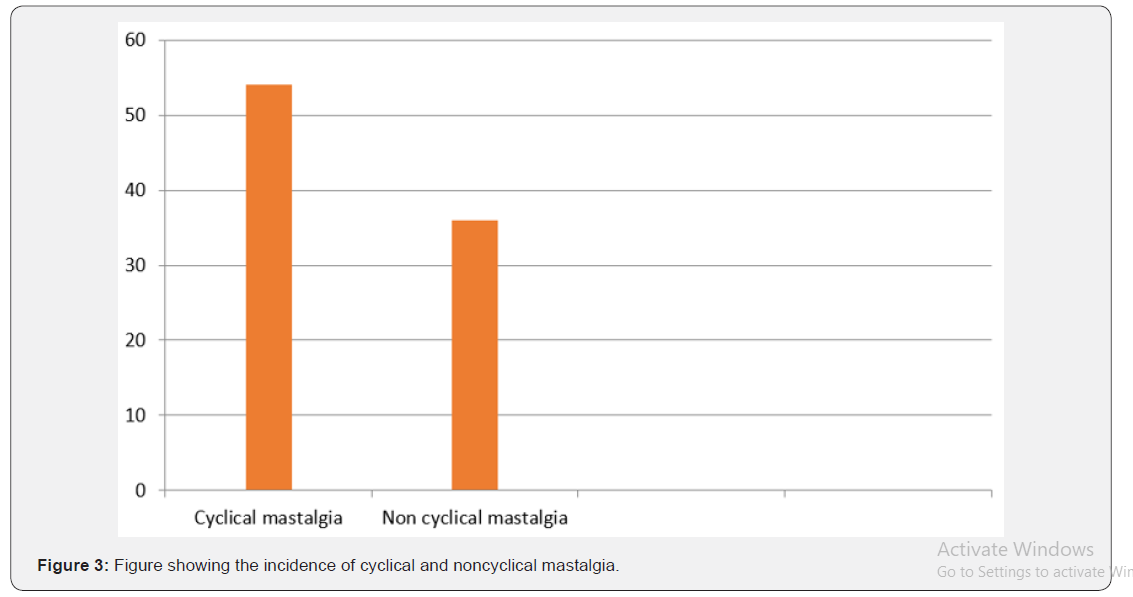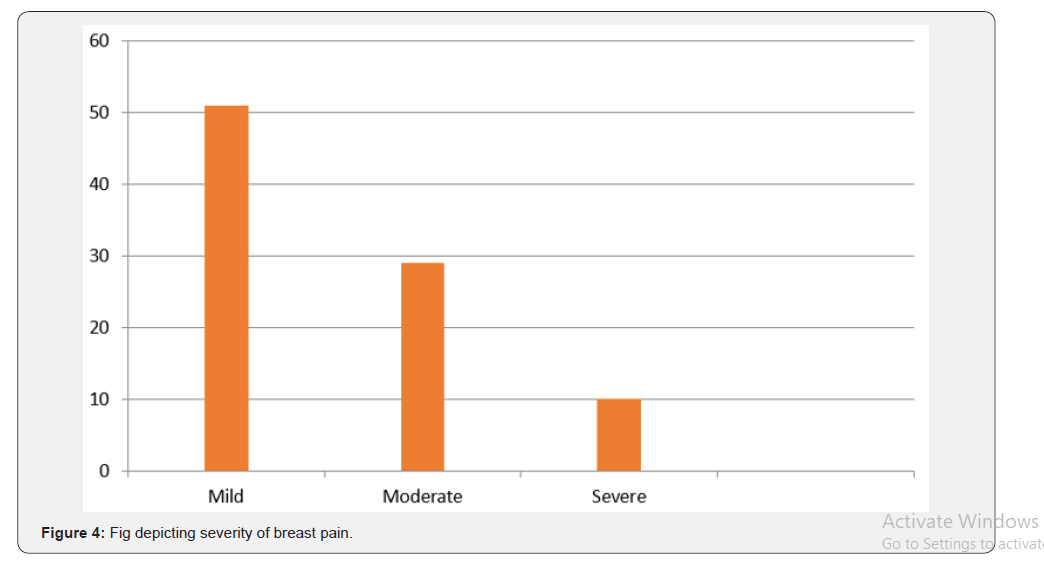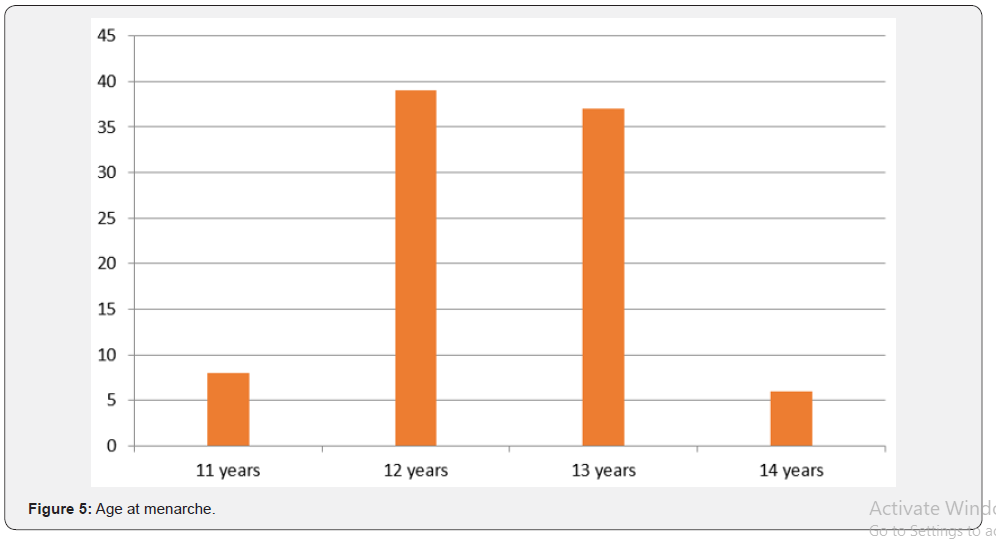Mastalgia: Etiopathogenesis and Management: A 2 Year Experience-Juniper Publishers
Juniper Publishers





Background: Mastalgia is breast pain and can vary in intensity from a mild tingling to a sharp pain. Objective: The purpose of this study was to determine the side incidence and age group affected in females presenting with mastalgia and present evidence-based concepts to provide with an overview of diagnosis and treatment. Methods: A total of 71 patients were included in the study and age and side incidence of patients with breast pain were investigated. Results: A total of 90 patients aged 31-60 years who presented with breast pain were followed up. Most patients presenting with mastalgia fell between the age group of 41-60 years and complained of cyclical, bilateral mastalgia. Conclusion: Mastalgia is the most frequent symptom of breast diseases and the fear that breast pain is a symptom of breast cancer and the presence of severe pain that affects a woman’s quality of life make it an important health issue worth discussing. Stress and anxiety play a crucial role in pathogenesis of mastalgia and reassurance, breast support brassiere, and topical NSAID gel massage form the initial management of mastalgia. Danazol, Bromocriptine, Evening primrose oil and Vitamin E have been seen to be effective in the treatment of mastalgia.
Keywords: Mastalgia; Cyclical mastalgia; Noncyclical mastalgia; Danazol; Bromocriptine; Evening primrose oil; Vitamin E; Flaxseeds
Introduction
Mastalgia is the most common breast symptom in patients attending a breast clinic [1]. 60 to 70 % of women experience some degree of breast pain at some stages of their lives, and in 10 to 20 % of cases, it is severe [2]. Mastalgia can be commonly associated with premenstrual syndrome, fibrocystic breast disease, psychological disturbance and, rarely in breast cancer [3]. Mechanical breast support, a low fat and high carbohydrate diet and topical nonsteroidal anti-inflammatory agents are reasonable first-line treatments. Hormonal agents such as bromocriptine, tamoxifen and danazol have all demonstrated efficacy in the treatment of mastalgia [3].
Aim
Breast pain is a common symptom and the concerns of patients presenting with mastalgia are the fear that breast pain is a symptom of breast cancer and the presence of severe pain that affects a woman’s quality of life. The purpose of this study was to determine the side incidence and age group affected in females presenting with mastalgia not responding to treatment with non-steroidal anti-inflammatory drugs and present evidence-based concepts to provide with an overview of diagnosis and treatment.
Materials and Methods
It is a prospective study of Mastalgia, wherein a group of females presenting with symptoms of breast pain were evaluated clinically and radiologically, treated and followed up till the symptoms were relieved. Only Ultrasonography of the breast was used as the imaging modality. All the participants in the study gave their informed consent and knew that objective of the Ultrasonography study was just to screen for a breast lump. Any patient who was found to have a breast lump on sonological examination was excluded from the study. The patients were routinely examined by the Lady Medical Officers and all the females with mastalgia were encouraged to report initially to the Lady medical officer who initially treated them with non-steroidal anti-inflammatory drugs were referred to the department of Surgery for further management only if there was no symptomatic relief after a week. The patients had free access to the Lady Medical Officer and were always encouraged to report about the nature, severity and timing of breast pain in relation to their menstrual cycle.
A total of 71 patients were included in the study. We investigated age and side incidence of patients with breast pain. Inclusion criteria included the patient having unilateral or bilateral cyclical breast pain. The characteristics of pain warranting inclusion in the study were tingling or mild pain which affected quality of life to severe unilateral or bilateral breast pain usually a week before the patient has her periods and pain reducing in severity after her periods. Patients who were excluded from the study were with a history of breast lump, nipple discharge, redness, breast retraction and pregnant and lactating women, known cases of breast cancer who have undergone surgery, patients with history of costochondritis, trauma and patients with cardiac and respiratory ailments
Results
During the 2-year period between Jun 2017 to Jun 2019, a total of 90 patients aged 31-60 years who presented with breast pain were followed up.
Age group affected

16 patients (17.77%) were between the age group of 31- 40 years, 45 patients (50%) were between 41-50 years and 29 patients (32.22%) were in the age bracket of 51-60 years (Figure 1). Most patients presenting with mastalgia (74 out of 90: 82.22%) fell between the age group of 41-60 years, 51 patients (56.66%) were evaluated to have mild pain, 29 patients (32.22%) had moderate pain and 10 patients (11.11%) complained to have severe pain.
Side incidence
63 patients (70%) complained of bilateral mastalgia, 16 patients (17.77%) had left sided breast pain and 11 patients (12.22%) complained of pain in the Right breast (Figure 2).

Cyclical versus non-cyclical mastalgia

54 patients (60%) complained of cyclical mastalgia whilst 36 patients (40%) presented with noncyclical mastalgia (Figure 3).
Severity of pain
Breast pain described by the patients was divided into mild, moderate and severe. Mild pain was pain lasting for about 15-20 min in a day and lasting for 1 week. Moderate pain was defined as pain lasting for 1-2 hours in a day and extending up to 2 weeks whereas severe pain was described as persistent breast pain for more than 2 weeks. 51 patients (56.66%) were evaluated to have mild pain, 29 patients (32.22%) had moderate pain and 10 patients (11.11%) complained to have severe pain (Figure 4).

Age of menarche

8 patients (8.88%) had menarche at the age of 11 years, 39 patients (43.33%) had menarche at 12 years of age, 37 patients (41.11%) at the age of 13 years and 6 patients (6.66%) at the age of 14 years (Figure 5).
Menopause 32
Patients (35%) out of 90 patients who presented with mastalgia had attained menopause. Relationship with the menstrual cycle in cyclical mastalgia: 54 out of 90 patients described their pain to be cyclical out of which 36 patients (66.66%) complained of mid cycle pain lasting for about a week, 10 patients (18.51%) revealed that they had mastalgia between 2nd and 3rd week of the menstrual cycle and 8 patients (14.81%) said that they had breast pain 1 week before having their periods and the pain reduced in intensity after their periods
Discussion
Mastalgia occurs most common in women aged between 30- 50 years 4 and is generally bilateral, diffuse, poorly localized, and generally described as a heaviness or soreness that often radiates to the axillae and arms [5]. There are contemplates which point towards a connection among mastalgia and mental stress [6]. Ader et al. [7] revealed that expanded caffeine utilization and smoking were related with mastalgia. Expanded estrogen levels, diminished progesterone levels, inconsistencies of the estrogen progesterone proportion, or expanded prolactin levels are related with mastalgia [8]. The cyclic nature of the breast pain, the presence of breast symptoms such as swelling, tenderness, and nodularity, and the cessation of these symptoms in the postmenopausal period are presumably because of the impacts of the estrogen hormone [9]. Mastalgia may occur due to fatty tissue necrosis, or a strain in the Cooper ligaments as results of either blunt or penetrating trauma to the breast [10]. An association between mastalgia and increased breast density has been accounted for [11]. Benign breast disorders are significantly associated with mastalgia [12] and public awareness of breast cancer has led to a steady flow of frightened females attending surgical outpatient clinics, with complaints of cyclical mastalgia, nodularity, or asymmetry, but a small proportion will indeed present with breast lumps [13].
Etiology
Expanded estrogen emission from the ovary is the most acknowledged theory of mastalgia. An examination from France demonstrated a fundamentally decreased degrees of progesterone in patients with mastalgia [14]. Peters et al. [15] discovered that the patients with mastalgia had a fundamentally more noteworthy ascent in prolactin contrasted and the controls. At the Cardiff Mastalgia Clinic, the total body water was estimated utilizing radioactive water in mastalgia patients and asymptomatic ordinary ladies and another speculation was put across that simple retention of body water may be associated with breast pain [16]. Astley Copper proposed that mastalgia patients were neurotic [17]. Minton et al. [18] announced that caffeine confinement delivered improvement in symptoms. Peters et al. [19] observed that breast pain was related decidedly with level of ductal dilatation, as shown by ultrasound studies
Investigation
Patients are explained about hormonal changes with menstruation and its relationship with mastalgia. A pain dairy is maintained by the patient and they record their daily pain experience on a chart. The severity of pain is also noted on a visual analogue scale (VAS) where 0 indicates no pain and 10 indicates very severe excruciating breast pain. Most experts consider any pain of ≥3 on a VAS of 0 to 10 to be significantly severe to require therapy [20]. Ultrasonography of the breast may be done to rule out any sub clinical lump and a mammogram may be performed for women above 35 years of age to see for cysts and other benign lesions which might be detected on a Mammogram.
Treatment
The majority of patients can be managed by exclusion of cancer and reassurance [21]. Anxiety and stress are significant components prompting mastalgia and anxiolytics have been concentrated to have a job in patients with mastalgia associated with anxiety and depressive symptoms. Danazol is the most effective drug in the treatment of cyclical and noncyclical mastalgia with Bromocriptine and Evening primrose oil having equal efficacy [21]. Danazol is given in the dose of 200mg /day on the second day of menstrual cycle for 2 months followed by 100mg/day for the next 2 months. Bromocriptine is started at a dose of 1.25mg /day and may be gradually increased up to 2.5mg/ day and continued for a period of 2 months. Evening primrose oil is given in the dose of 3gm/day for a period of 4-6 months. Evening primrose oil, which contains omega-6 essential fatty acids and its effective component is believed to be gamma-linolenic acid [22]. Vitamin E has also been used in treatment of mastalgia effectively. Daily doses of 1,200 IU vitamin E and 3,000mg EPO in combination taken for six months may decrease the severity of cyclical mastalgia [23]. Flaxseed with the scientific name Linum usitatissimum contains omega-3 fatty acid and through it, the production of some arachidonate metabolites are reduced, and eicosanoids derived from omega-3 found in flaxseed, have antiinflammatory properties [24]. The study of Alvandipour et al. [25] showed that evening primrose oil and Vitamin E have similar therapeutic effects in reducing breast pains. Primrose oil capsules are also available and are given in the dose of two 1000mg capsules daily whereas Vitamin E is given as 400 IU capsule daily for a period of 2 months. Inverse relationship between mastalgia and breast cancer: Women who experience breast pain are less inclined to be determined to have breast cancer than women who do not complain of breast pain [26]. Despite the fact that mastalgia isn’t viewed as an indication of malignancy in essence, its presence does not rule out the presence of cancer, either. A study by Arslan et al. [27] uncovered that 0.2% of the women with mastalgia were diagnosed with breast cancer.
Conclusion
Mastalgia is the most frequent symptom of breast diseases and the fear that breast pain is a symptom of breast cancer and the presence of severe pain that affects a woman’s quality of life make it an important health issue worth discussing. Stress and anxiety play a crucial role in pathogenesis of mastalgia and reassurance, breast support brassiere, and topical NSAID gel massage form the initial management of mastalgia. Danazol, Bromocriptine, Evening primrose oil and Vitamin E have been seen to be effective in the treatment of mastalgia. The most common age group affected is between 41-50 years and breast pain involving both breasts is the commonest. Cyclical mastalgia is commoner than non-cyclical mastalgia and mild pain which is described as pain lasting for about 15-20min in a day and lasting for 1 week affected most patients suffering from mastalgia. Most patients complained of mid cycle pain lasting for about a week. Early menarche and late menopause may be associated with mastalgia and the most common age of attaining menarche in patients who reported with mastalgia was at 12 years of age. Women who experience breast pain are less likely to be diagnosed with breast cancer and 0.2% of the women with mastalgia were diagnosed with breast cancer.
For more Open access journals please visit our site: Juniper Publishers
For more articles please click on Journal of Complementary Medicine & Alternative Healthcare




Comments
Post a Comment